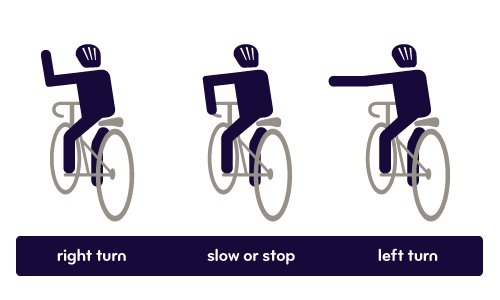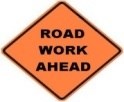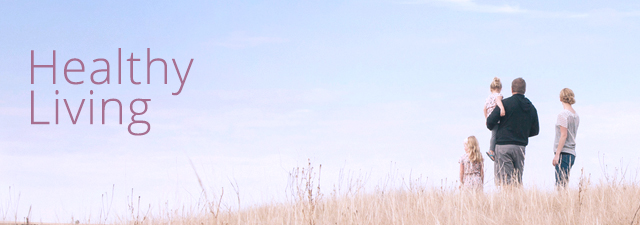Algoma Public Health
- Road & Off-Road Safety
- Share the Road
- Back
- Healthy Living >
- Injury Prevention >
- Road & Off-Road Safety >
Road & Off-Road Safety
Bicycle and Helmet Safety
Biking is a fun and healthy activity for the whole family. Biking is a good form of transportation that is good for your body, and the planet. Under the Ontario Highway Traffic Act (HTA), a bicycle is a vehicle (not a toy) that has one, two or three wheels, has steering handlebars and pedals and does not have a motor. Bike helmets can prevent up to 88% of brain injuries when properly fitted and used correctly.
Rules of the Road
As a cyclist, you must share the road with others (e.g. cars, buses, trucks, motorcycles, pedestrians, other bicycles etc ...).
DO:
- Learn hand signals and use them early when turning or stopping:

- Know the rules, obey all Traffic Signs and Signals
 |
Bicycles are permitted on this road. |
 |
No bicycles permitted on this road. |
 |
Come to a full stop and wait until the intersection is clear before proceeding. |
 |
Yield to traffic in the intersection or close to it. Stop if necessary and go only when the way is clear. |
 |
Roadwork ahead. The speed limit and lanes may be reduced. |
 |
Railway crossing ahead. The sign also shows the angle at which the railway tracks cross the road. |
 |
One-way road. Travel in the direction of arrow. |
 |
These signs indicated diamond lanes for specific types of vehicles, either all the time during certain hours. The can include buses, taxis, bicycles, and vehicles with three or more people. |
 |
Flashing Yellow: Slow down and proceed with caution through intersections. Flashing Red: Stop and move through the intersection when it is safe to do so. A flashing, or advance, green light or left-pointing arrow with a green light, permits you to turn left, go straight ahead or turn right from the proper lane as the oncoming traffic still faces a red light. |
- Ride as near to right hand curb as possible (approximately 1 meter) in the same direction as the moving cars.
- Ride in single file if you are riding with others
- Ride beside parked cars as if all the car doors were open
- Stay alert: watch for cars pulling out of intersections/driveways; make eye contact with drivers.
- Ride on bike paths where available
- Get off your bike and walk, if crossing busy corners
- Look over your shoulder before you decide to move out, or turn onto the road
- Be a courteous bike rider (e.g. shouting "passing on the left") when overtaking other cyclists and pedestrians; always yielding to hikers and horse riders
DON'T:
- Leave your bike unattended without locking it up
- Ride your bike until it has been properly equipped with reflectors, lights and horn/bell
- Ride double
- Ride in areas where bicycles are not allowed
- Follow vehicles too closely
- Ride on the sidewalk unless otherwise indicated
- Ride at night unless absolutely necessary
- Ride without a helmet, ever
Tips to prevent bicycle related injuries
In addition to following the "Rules of the Road", be cool, and follow some additional basic safety tips when you ride:
- Wear a safety approved bicycle helmet
- Ride a bike that is adjusted to fit your height
- Keep both feet on the pedals
- Keep pant legs tucked in
- Always wear shoes with a closed toe
- Keep your bicycle in good repair; do an ABC check before you ride:
- A is for Air in your tires
- B is for Brakes and Bars
- C is for Chain and Crank
- Control your bicycle: keep both hands on the handlebars, unless you are signalling to turn.
- See and be seen: wear bright, neon, fluorescent or reflective clothing; yellow and white stand out best at night.
- Use pedal reflectors and reflective materials on wrists, ankles, and heels
- Watch for and avoid road hazards such as debris, potholes, ice, broken glass, puddles, gravel, sharp rocks and dogs!
Legislation, License and Registration
The HTA requires children and youth under the age of 18 to wear a safety approved bicycle helmet. Parents and guardians can be fined for allowing their child to ride a bicycle without a helmet. A conviction carries a set fine of $60, plus a Victim Fine Surcharge of $15 and an administration fee of $5.
- Bike Helmet Legislation Chart
- Bicycles do not require registration, license plate, vehicle insurance, or a driver's license. However, registering your bike with the Police may assist in the recovery of your bicycle, if stolen.
- By law, your bicycle must have a white front light and a red rear light or reflector when you ride between one-half hour before sunset and one-half hour after sunrise; and white reflective strips on the front forks and red reflective strips on the rear stays, as well as a working bell or horn.
Bicycle Helmets
Wearing a bicycle safety approved helmet can greatly reduce the risk of permanent injury or death. Wearing a helmet reduces the force of an impact on your skull and how much your brain will crash around inside of your skull if you hit your head. Helmets (to date) do not prevent concussions, and cannot prevent all head injuries.
- Wear your helmet right every time! 2V1 rule of Helmet Fitting
- Replace your helmet after 5 years (plastics dry out), and after a crash or dropping your helmet hard (foam inside helmet can crack), even if there is no visible damage
- Parents, coaches, educators are encouraged to model safe, responsible behaviours, like wearing a properly fitted helmet when biking.
Bike Helmet No-No's
- No high pony tails
- No hats under helmet
- No added stickers on helmet
- No character attachments
- No throwing helmet around
- No using cracked or dented helmets
Tips to help you get your kids to wear their helmets:
- Start early. Get into the helmet habit with your child's very first set of wheels
- Take your child shopping. Let your child pick out the helmet he or she likes.
- Fit founds. Try helmets on in the store.
- Explain. Tell your child how a helmet protects the head and brain
- Positive re-enforcement. Praise and reward your child for wearing a helmet
- Be firm. Always insist your child wear a helmet when he or she is out on wheels.
- Be a role model. When you're out on wheels, wear your own helmet.
Bicycle Safety Resources
- Child Safety good Practice Guide:http://horizon.parachutecanada.org/wp-content/uploads/2014/09/GoodPracticeGuide1.pdf
- Bicycle safety: www.mto.gov.on.ca/english/safety/bicycle-safety.shtml
- The Ontario Cycling Association: an organization that offers CAN-BIKE courses in bike safety www.ontariocycling.org
- Bicycle Trade Association of Canada (BTAC) www.btac.org
- Cycling skills Ontario’s Guide to Safe Cycling a detailed handbook of rules and safety standards for any rider: http://www.mto.gov.on.ca/english/safety/pdfs/cycling-skills.pdf
- Young Cyclist Guide, a kid-friendly handbook book of cycling safety tips and rules for young riders: http://www.mto.gov.on.ca/english/safety/pdfs/young-cyclist-guide.pdf
- Ontario Cycling Association: http://www.ontariocycling.org/can-bike/
- Ministry of Transportation of Ontario and OPHEA. Road Safety Resource. 2009 Grade K-3, Grades 4-6, and Grades 7-8. www.ontarioroadsafety.ca
Parachute. Fact Sheet Brain Injuries. www.parachutecanada.org
Ministry of Transportation www.mto.gov.on.ca
Ministry of Transportation of Ontario and OPHEA. Road Safety Resource. 2009
Distracted Driving
A driver's judgment is comprised when they are not fully focused on the road. Distracted driving is a serious issue and is increasing the number of collisions and fatalities on our roads.
For more information on distracted driving, the legalities and penalties, check out the Ministry of Transportation.
Distracted Driving Includes:
- Talking or texting on a cell phone
- Reading books, maps or using a GPS
- Eating and/or drinking
- Smoking
- Personal grooming
- Adjusting the radio
- Playing extremely loud music
- Talking to passengers
- Tending to children in the backseat
- Driving while fatigued (mentally and/or physically)
What Can You Do To Reduce Distracted Driving?
Plan Your Route - Plan how much time you'll need to reach your destination, road closures to avoid, and the best time to leave. If you will be using a GPS system, program your route prior to starting the car. This includes your personal vehicle as well as a vehicle used for work.
Put your Cell Phone Away - Cell phones should be out of reach. Reduce the temptation by keeping it out of sight, like in the trunk or in a bag, and turn the ringer off. Most smartphones can now be set up to send an auto reply when you receive a text or phone call. Ask your passenger to respond to a message if it is truly important.
Passengers - Advise your passengers to be quiet while you are driving. Pull over to a safe place to deal with situations involving children in the car.
Eating, Drinking and Smoking - It's best to avoid eating, drinking and smoking while driving.
Music - Music should never be so loud that you would not be able to hear emergency vehicle sirens. Make music selections when the vehicle is not in motion.
Personal Grooming - Do your hair, makeup, etc. at home or upon arrival, not while driving a vehicle.
Secure Objects - Place any items like purses, backpacks and coats in the trunk or safely tucked behind the seat on the ground so they will not provide a distraction to you.
Source: RCMP, OPP
When driving, take extra care when passing cyclists, be sure to leave a minimum length of one metre. Not only is it best practice but it is also the law. By maintaining the necessary gap you are doing your part in reducing the number of bicycle related collisions or crashes.Sharing the Road applies both to motorists and cyclists.
Background
Share the Road is a public initiative that took affect in 2014 and is designed to help motorists and cyclists be aware of the responsibilities when it comes to sharing the road with cyclists as outlined in Bill 173 of the Highway Traffic Amendment Act.
Frequently Asked Questions
Q: Will cyclists also be required to leave a minimum one-metre distance when passing a vehicle?
A: Cyclists are not required to leave a specific one-metre space; however, they are required to obey all the rules of the road. Cyclists who are being overtaken should turn out to the right to allow the vehicle to pass.
Q: What if there isn’t enough room to allow for a one-metre passing distance? Can a vehicle cross the centre median line to pass the cyclist?
A: A motorist may, if done safely, and in compliance with the rules of the road, cross the centre line of a roadway in order to pass a cyclist. If this cannot be done, he or she must wait behind the cyclist until it is safe to pass.
Bike Lane Basics
What are Bike Lanes?
Bike lanes are market portions of the road dedicated exclusively to cyclists. The lane is marked with a white line bicycle symbol
Who can use the Bike Lanes?
Only bicycles and E-bikes are permitted to use the bike lanes, motorcyclists, scooters, skateboards, roller bladers, pedestrians and vehicles are not permitted to use the bike lane
How do I use Bike Lanes?
Cyclists travel in the middle of the bike lane in the same direction of traffic. Cyclists follow the same rules of the road as other vehicles.
Rules of the Road
Motorists may cross a bike lane to turn right at an intersection or access a driveway
Leaving Room for Cyclists
Bicyclists are more vulnerable road users than motorists. They are smaller and quieter. A small mistake by a motorist can result in serious injury or death to a cyclist. Motorists must respect the rights of other road users, especially bicyclists.
- Pass the cyclists when the road ahead is clear and proceed with caution
- Give at least one metre of space between you and the cyclist when passing
- Check over your shoulder, and always check your blind spots, before moving back into your travel lane as cyclists could be there
- Check for cyclists before opening your car door
- Watch for cyclists before making any left or right turns as they could be proceeding straight through the intersection
- Do not enter any given bike lane, when turning right, turn around the bike lane
- Do not honk at cyclists as it can startle them leading them to lose control of the bike
And don't forget to Be Patient:
- Use extra caution when driving near children playing, walking or cycling, as well as older pedestrians/cyclists who may not hear or see you
- Remember children and novice cyclists can be unpredictable, expect the unexpected
But most of all try cycling or walking as a way of getting around... you may like it! - Get out there and ride your bike. They have a way of changing lives as it is not only good for you it is good for the environment. Not to mention it can save you money.
Walk this Way
Whether we are in a vehicle, riding a bike, or on foot we all have places we need to go. Take extra care when walking by following these tips to stay safe:
- Be visible. Wear bright/light coloured clothing and reflective materials.
- Always walk on the sidewalk. If there is no sidewalk, walk facing traffic.
- Cross streets at marked crosswalks, if possible. Obey traffic signals such as walk/don’t walk signals, but do not rely solely on these. Look before you cross the road; make eye contact with drivers.
- Be alert. Do not wear headphones or talk on a cell phone while walking and especially while crossing roadways.
Impaired driving means operating a vehicle (including cars, trucks, boats, snowmobiles and off-road vehicles) while your ability to do so has been compromised by consuming alcohol, drugs or a combination of the two.
Illegal drugs, cannabis, over-the-counter and prescription medications, as well as alcohol can affect your judgment, reaction time, coordination and motor skills. Even a small amount of alcohol or drugs, no matter how they are taken, can impair your ability to drive. Stress and fatigue can also impair your ability to drive. When you drive impaired your risk of crashing more than doubles.1 Alcohol-impaired driving is one of the leading causes of death on Ontario’s roads.
For more information about impaired driving, the risks associated with impaired driving, and the legalities you may face, visit the Ministry of Transportation, Health Canada, and Canadian Centre on Substance Use and Addiction.
- Have a designated driver
- Call a friend or loved one
- Call a cab or ride-share
- Take a public transit
- Stay over
Off Road Vehicles
All-terrain vehicles (ATVs) and off-road vehicles (ORVs) are designed with fun in mind. However, they can also be very dangerous. ATVs cause more permanent disabilities and death than most other sport or recreational activities. You risk serious or even fatal injuries to yourself and others if you do not respect applicable laws and regulations or if you ignore suggested safety standards when operation recreation vehicles.
On average, more than 15 people each day are seen in Ontario emergency departments and at least one person is hospitalized daily for injuries related to all-terrain vehicles. The provincial age for ATV related injuries is substantially higher in Northern Ontario than elsewhere in the province, with males between the ages of 15 and 19 years of age making up the majority of reported incidents.
Source: Ontario Injury Compass Vol. 5, Issue 7
What are the Major Causes of Injury?
- Driver inexperience
- Speed
- Impairment
- No helmet/improper attire
- Driving on paved roads
- Lack of vehicle maintenance
How to Plan for a Fun & Safe Ride
- Take an ATV Safety Course.
- Know how your particular vehicle works and know its limits. Read the operators manual.
- Check weather forecasts before heading out.
- Let someone know where you are going and when you expect to return. Use maps and compasses in unfamiliar territory. Stay put if you are lost.
- Do a pre-ride inspection: gas, oil and other fluid levels; lights; breaks; tires and air pressure.
- Carry a First Aid and vehicle repair kit.
- Wear appropriate safety gear to prevent injury and bring clothing for visibility.
- Always ride with a companion or in a group.
- Ride according to trail, road, and weather conditions.
- Stay in control. Ride within your skill level and abilities.
- Ride on designated trails and respect the environment.
- Drive sober. It is against the law to drive while impaired by alcohol or drugs.
*It is your responsibility to make yourself aware of any relevant bylaws enacted by the municipality where you will be riding.
MTO ATV Legislation & Guidelines
For more information on ATV legislation, recent changes to provincial ORV and ATV safety requirements and a comprehensive list of safety rules and tips, please see the Ministry of Transportation.
Learn more about car seats on our Pregnancy & Parenting - Injury Prevention webpage.
Date of Creation: June 1, 2015
Last Modified: June 12, 2019










